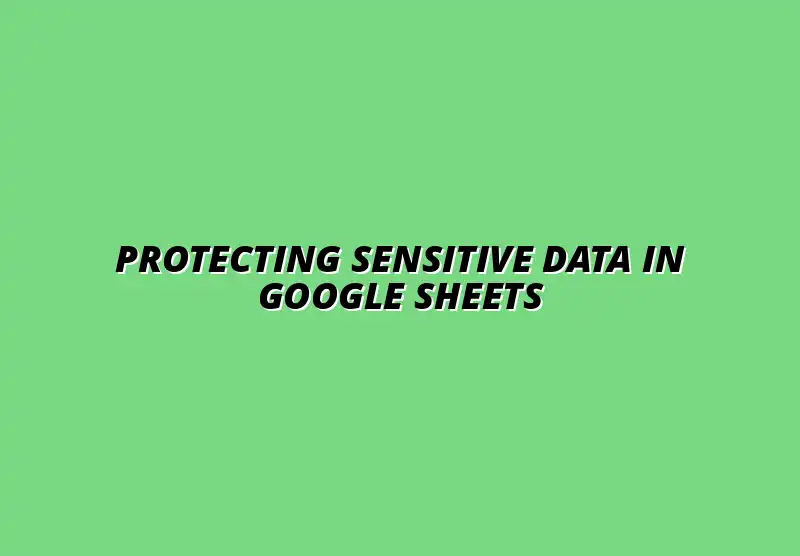Protecting Sensitive Data in Google Sheets

Understanding Sensitive Data in Google Sheets
When we talk about sensitive data, we are referring to any information that must be kept secure to protect someone's privacy or the integrity of a business. Examples of sensitive data can include personal identification numbers, financial records, and confidential business plans. Understanding what sensitive data is and why it matters is the first step towards safeguarding it.
As we increasingly use tools like Google Sheets for storing and sharing information, protecting sensitive data becomes more critical. Mismanagement of this data can lead to severe consequences, such as identity theft, financial loss, or damage to a company’s reputation. Therefore, being aware of what constitutes sensitive data helps ensure that we handle it with care. For more tips on protecting your data, check out these data security tips for Google Sheets.
Defining Sensitive Data and Its Importance
So, what exactly constitutes sensitive data? Well, it can be categorized into several types. Generally, sensitive data may include:
- Personal Identifiable Information (PII): Names, addresses, social security numbers.
- Financial Information: Credit card details, bank statements, salaries.
- Health Records: Medical histories, treatment plans, insurance details.
By identifying these categories, we can better understand their significance and the risks associated with them. For instance, if personal identification information is leaked, it could lead to identity fraud, while a leak of financial information could result in significant monetary losses. Managing large datasets effectively is crucial; learn how to manage large datasets in Google Sheets efficiently.
What Constitutes Sensitive Data?
In addition to the examples mentioned earlier, sensitive data can also include proprietary business information such as trade secrets, marketing strategies, and customer lists. Each of these data types requires strict protection to prevent unauthorized access. The identification of sensitive data is crucial for setting appropriate security measures.
To sum it up, sensitive data is not just limited to personal information. It encompasses any form of data that, if exposed, could harm individuals or organizations. Recognizing this broad definition helps us understand the need for rigorous protection protocols.
Why Protecting Sensitive Data is Essential
Now that we know what sensitive data is, it’s vital to understand why protecting it is so important. The protection of sensitive data is essential for various reasons, including:
- Maintaining trust with clients and stakeholders.
- Ensuring compliance with regulations and laws.
- Preventing financial losses and potential lawsuits.
In today's digital age, where data breaches are becoming more common, a proactive approach to protecting sensitive information is not just advisable; it's necessary. Organizations must prioritize data security to avoid the catastrophic consequences of data exposure. Automating data entry can significantly improve efficiency and reduce errors. Discover how to automate Google Sheets data entry.
Exploring Security Risks Associated with Google Sheets
Google Sheets is a powerful tool for data management, but it also poses several security risks. Understanding these vulnerabilities is key to protecting your sensitive information. Among the most common risks are data exposure and unauthorized access, which can lead to significant problems if not addressed.
When people share Google Sheets without proper controls, sensitive data can easily fall into the wrong hands. Additionally, if proper access permissions aren’t set, unauthorized users can access, modify, or even delete critical information. Identifying these risks allows us to take the necessary preventive measures to secure our data. Learn how to protect your Google Sheets data effectively.
Common Vulnerabilities in Google Sheets
There are several vulnerabilities that users should be aware of when using Google Sheets. Here are a few common ones:
- Data Exposure Risks: Inappropriately shared documents can lead to unintended access.
- Insecure Links: Sharing edit links without restrictions can expose sensitive data.
- Weak Passwords: Using simple passwords can make accounts vulnerable to hacking.
Each vulnerability poses a unique threat, and understanding them is the first step toward protecting sensitive information. By addressing these risks, users can create a more secure environment for their data. Effective collaboration is key to productivity. Discover tips on collaborating effectively in Google Sheets.
Data Exposure Risks in Shared Documents
One of the most significant risks when using shared documents is the potential for data exposure. If a spreadsheet containing sensitive information is shared with too many people or shared incorrectly, anyone with access can view the data. This can lead to serious breaches of confidentiality and privacy.
To minimize these risks, it’s essential to review sharing settings regularly and limit access to only those who need it. Implementing proper sharing protocols can drastically reduce the chance of sensitive data being exposed to unauthorized individuals.
Unauthorized Access and Data Breaches
Unauthorized access occurs when individuals gain access to sensitive data without permission. This could happen due to weak account security, phishing attacks, or simply by being given too much access. The consequences can be dire, resulting in data breaches that compromise sensitive information.
Companies must take steps to safeguard against unauthorized access by implementing robust access controls and regularly updating security settings. A proactive approach can make a significant difference in preventing data breaches. Automating tasks in Google Sheets can streamline workflows and enhance security. Check out these Google Sheets automation tips.
Impact of Data Loss on Businesses
The impact of data loss on businesses can be devastating. From financial losses to damage to reputation, the consequences are far-reaching. Understanding these impacts can motivate organizations to prioritize data protection.
Data loss can disrupt business operations, lead to loss of customers, and incur hefty legal fees due to non-compliance with data protection laws. Therefore, recognizing the importance of safeguarding sensitive data is essential in today’s business landscape.
Consequences of Sensitive Information Leaks
When sensitive information is leaked, the ramifications can be severe. Organizations may experience:
- Loss of Customer Trust: Clients may hesitate to engage with a company that has faced data breaches.
- Legal Repercussions: Companies can face fines for failing to protect sensitive data.
- Operational Disruption: Recovery efforts can divert resources and hinder regular operations.
These consequences emphasize the need for organizations to take data protection seriously. The potential fallout from a data leak is a strong motivator for implementing effective security strategies. Learn how to automate Google Sheets with Zapier for improved efficiency and security.
Financial and Reputational Damage
Financial losses from data breaches can be staggering. Companies may face immediate costs to remediate the breach, alongside long-term losses due to a damaged reputation. Rebuilding brand trust can take years, and in many cases, it never fully recovers.
The financial implications are clear, and the reputational damage can have a lasting impact on customer relationships. Therefore, organizations must invest in security measures to protect sensitive data from the outset.
Maintaining Vigilance in Data Protection Practices
Keeping your data secure in Google Sheets is not a one-time task; it requires ongoing effort and attention. By maintaining vigilance, you can better protect sensitive information from potential threats. This means staying informed about the latest security features, regularly monitoring usage, and adapting your strategies as necessary!
Staying Updated with Google Sheets Security Features
One of the best ways to enhance data security is by taking advantage of regular updates from Google. These updates often include new features and enhancements designed to improve your data protection efforts. By staying informed about these updates, you can make sure your organization is always utilizing the most effective security measures available.
Always keep an eye on Google’s security announcements. These communications often highlight important changes, new security features, and tips for better management of sensitive data. By being proactive and aware, you can adapt your practices to align with the latest recommendations!
- Check Google Workspace blog for updates.
- Subscribe to security newsletters.
- Attend webinars or training sessions on new features.
Monitoring Access and Usage of Google Sheets
Another important aspect of data protection is monitoring how Google Sheets is being used within your organization. The Activity Dashboard is a powerful tool that helps you track user interactions with your documents. With this feature, you can see who is accessing your sheets and what changes they are making.
By regularly reviewing this dashboard, you can identify any unusual or suspicious activities. This could include unauthorized access attempts or unusual changes made to sensitive data. If you notice anything out of the ordinary, act quickly to investigate and resolve the issue!
- Check the Activity Dashboard weekly.
- Set alerts for unusual access patterns.
- Conduct regular audits on document access.
Evaluating Third-Party Tools for Enhanced Security
Sometimes, built-in features may not be enough to meet your organization’s security needs. In these cases, considering third-party security tools can be a great option. These tools can offer additional layers of protection and help you safeguard sensitive data in Google Sheets.
When to Consider Additional Security Tools
If you are handling exceptionally sensitive information, it may be time to look into specialized security applications. These tools are designed to work alongside Google Sheets, providing enhanced protection and monitoring. Understanding when to integrate these tools is crucial for maintaining a secure environment!
Evaluate the following conditions to determine whether third-party tools are necessary:
- Handling highly sensitive data that requires compliance with regulations.
- Experiencing frequent unauthorized access attempts.
- Desiring advanced features not available in Google Sheets.
Establishing a Culture of Data Security in Organizations
Building a strong culture of data security is essential for long-term success. Employees must understand the importance of protecting sensitive information and feel empowered to adhere to security protocols. Continuous training and awareness programs can help create a workforce that prioritizes data protection.
Encouraging employees to adopt best security practices is key to fostering a secure environment. Make data security a part of your team's everyday conversations and actions, and watch how it positively impacts your organization!
- Conduct regular training sessions on data protection.
- Implement security awareness campaigns.
- Incorporate security best practices into onboarding processes.
Summarizing Key Takeaways for Protecting Sensitive Data
In conclusion, protecting sensitive data in Google Sheets requires a multi-faceted approach. Prioritizing access control and encryption, alongside a commitment to regular monitoring and updates, creates a solid foundation for data security. Remember, the more proactive you are, the safer your information will be!
Encouraging Proactive Measures for Data Security
Ultimately, safeguarding information in Google Sheets is a shared responsibility. By implementing best practices today, you can significantly reduce the risks associated with data exposure. Let's commit to making data security a top priority and stay vigilant against potential threats!
Take action now – review your current practices, train your team, and explore the security tools available. Together, we can ensure our sensitive data remains protected!
Popular Posts
 Understanding the Importance of Shortcuts in Google Sheets for Power Users
When it comes to working
Understanding the Importance of Shortcuts in Google Sheets for Power Users
When it comes to working
 Understanding Google Sheets and Its Importance
Google Sheets is a powerful, web-based spreadsheet ap
Understanding Google Sheets and Its Importance
Google Sheets is a powerful, web-based spreadsheet ap
 Understanding Shortcuts in Google Sheets
When it comes to working efficiently with Google Sheets, kn
Understanding Shortcuts in Google Sheets
When it comes to working efficiently with Google Sheets, kn
 Understanding the Value of Add-ons in Google Sheets for Enhanced Productivity
Google Sheets is a pow
Understanding the Value of Add-ons in Google Sheets for Enhanced Productivity
Google Sheets is a pow
